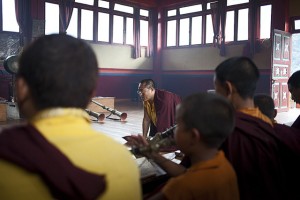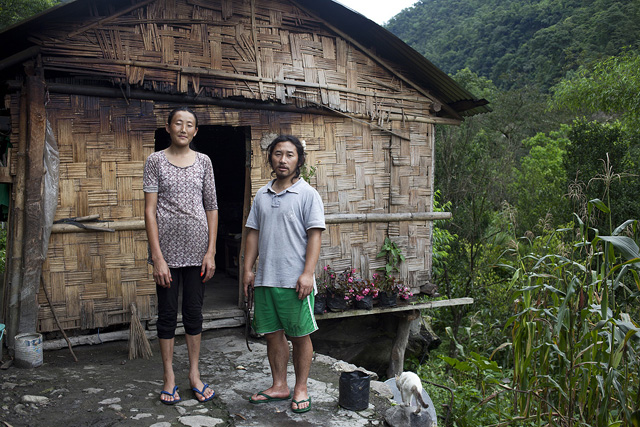Indian photojournalist Nikhil Roshan visited Passingdang, a village in the Dzongu Reserve of Sikkim, to assess the feelings of the Lepcha toward the proposed dams that threaten their culture and society. Roshan used the possible destruction of the free flowing Teesta River and its tributaries in northern Sikkim as a jumping off point for a wide-ranging review of Lepcha beliefs and practices which was published on November 27.
He published similar information in an even longer essay, with more details about the stresses and beliefs of the Lepcha, two months earlier, on September 21. The two essays vary, but the earlier one has more information and should be studied carefully by anyone interested in the unique perspectives of the Lepcha people.

Roshan begins his September essay by interviewing Ren Likden Rongkup, a Buddhist monk, in a monastery located on a hill above Passingdang. “We are resigned to our fate, but I believe that our faith will save us from the dam,” the monk tells the author. His comments reflect the general mood Roshan finds in the community. People are weary of the struggle, but they are watchful and not about to give up. He writes that in 2004 the government of Sikkim proposed seven large dams inside the Dzongu Reserve generating almost 1000 megawatts of hydropower.
The Lepcha believe that the Teesta and its tributaries represent pathways for their souls to travel up to Kanchenjunga, the sacred mountain on the western border of Sikkim and the third highest point on the globe. Construction of the dams and tunnels would prevent the souls from making their journeys. Also, not incidentally, they would impair the natural environment by depleting the fishery, removing some of the water for crop irrigation, and harming the plants, insects, and birds that live near the river.
Fired up by their concerns, several Lepcha in 2007 formed Affected Citizens of Teesta (ACT), a group that protested on the streets of the state capital, Gangtok, and received a lot of publicity as a result. The two leaders of the protests, Dawa Lepcha and Tenzing Gyatso, staged hunger strikes and sit-ins to dramatize the Lepcha position.
Dawa Lepcha tells the author that the state government at that time derided ACT as an ethnic and communal group, which it clearly was not. Today, he is a member of a political party called the Sikkim Krantikari Morcha (SKM), a group that opposes the work of Pawan Chamling, the Chief Minister of the state for 26 years.
The government likes to paint a happy picture of the three major ethnic groups in Sikkim—the Lepchas, the Bhutias, and the Nepalis—as living in a state of constant harmony, which is clearly not the case, he says. “There is every possibility of linguistic politics being practiced here in [the] future.”
While he is visiting Passingdang, Roshan visits Tenzing Gyatso, one of the ACT leaders. Nowadays he is working on his cardamom plantation far down the hill. He spends most of his time with his wife in their modest bamboo house and working in his fields. His comments strike the author as brimming with vitality. “We are going back to the land. The dams truly opened our eyes to the fact that Sikkim was selling off its hills and rivers,” he says.

Gyatso takes Roshan on a walk through a grove of orange trees to see a new house he is building. He says, with obvious pride, “it is ironic that the model of sustainable tourism that the state now follows in a big way started right here in Dzongu, amongst us protestors.” He plans to use his new, much larger house, to host more tourists in a better homestay facility than he has now. He links the protest movement of eight years ago to the flourishing tourist business today.
“Some of my fellow protestors and I began running homestays when the anti-dam agitations began, both as a way to sustain ourselves and the movement. Besides it is a good way to raise awareness amongst visitors about our struggle. This land, after all, is our identity,” he explains.
Roshan looks out across the valley and agrees that the landscape is certainly worth preserving. He sees a “stunning diversity” in the landscape, the flora, and the fauna. He recognizes that the Lepcha have not lost their intimate connection with nature, so their need to preserve the natural environment is obvious.

Gyatso tells Roshan that during the night of August 16, 2007, after the state had already paid the first installment of compensation for their community, a flash flood occurred which washed away machinery left near the river by the construction company at the Panan Dam site—and a few engineers to boot. “Nature is with us,” Gyatso suggests.
Roshan explains that the Panan Dam site also happens to be in the buffer zone of the Kanchenjunga National Park. The government of Sikkim may now be moving with care about that proposed dam site since it intends to nominate the park for UNESCO World Heritage status. The moratorium also has helped quiet the agitation by the Lepcha people to preserve their heritage—at least while the government is not moving forward. The hiatus in construction activity may be helping the Lepcha develop their own paradigms for small-scale development projects, such as the successful homestay program for tourists.